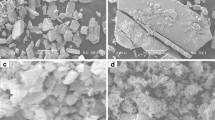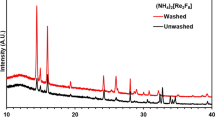Abstract
Thermal decomposition of tetraethyl ammonium tetrafluoroborate has been studied employing simultaneous techniques of TG–DTG–DSC—quadrupole mass spectrometric techniques in an inert atmosphere of pure Helium gas at a sample heating rate of 5 K min−1 employing a platinum crucible. The observed decomposition paths are the most commonly expected Hofmann elimination and substitution reactions paths.






Similar content being viewed by others
References
Flanigen EM. A comprehensive review article concerning both high- silica zeolites and silica molecular sieves. Proceedings of international conference on Zeolites, 5th, Heyden, London; 1980. p. 760–780.
Kerr GT. Zeolite ZK-5: a new molecular sieve. Science. 1963;140:1412.
Acara NA. Aluminosilicates of zeolite n structure. US Patent 3,414,602; 1968.
Rubin MK, Rosinski, EJ, Plank CJ. Crystalline zeolite ZSM-34 and method of preparing the same. US Patent 4,086,186; 1978.
See EG. Gmelin Handbook, 8th Edn. Boron compounds. 2nd Supplement. 1982;2:53–6.
Sergey S, Pauls JR, Nunes SP, Peinemann KV. Quaternary ammonium membrane materials for CO2 separation. J Membr Sci. 2010;359:44–53.
Krásensky S, Studnicková M. Electro synthesis of organic amalgam from tetraethyl ammonium tetrafluoroborate in aqueous medium. Collect Czech Chem Commune. 1994;59:2375–82.
Prasad MRR, Krishnan K, Ninan KN, Krishnamurthy VN. Thermal decomposition of tetraalkyl ammonium tetrafluoroborates. Thermochim Acta. 1997;297:207–10.
Yanes EG, Gratz SR, Stalcup AM. Tetraethyl ammonium tetrafluoroborate: a novel electrolyte with a unique role in the capillary electrophoretic separation of polyphenols found in grape seed extracts. Analyst. 2000;125:1919–23.
Pieniazek PA, Stangret J. Hydration of TEATFB in aqueous solutions by means of FTIR spectroscopy. Vib Spectrosc. 2005;39:81–7.
Kurzweil P, Chwisteka M. Electrochemical stability of organic electrolytes in supercapacitors: spectroscopy and gas analysis of decomposition products. J Power Sour. 2008;176:555–67.
Giuseppetti G, Tadini C, Ferloni P, Zabinska G, Torre S. The crystal structure of tetraethyl ammonium tetrafluoroborate (C2H5)4NBF4. Z Kristallogr. 1994;209:509–11.
Subramaniam K. A review of electrosynthesis of polysilanes. J Macromol Sci-Rev Macromol Chem Phys. 1998;C38:637–50.
Vijayanathan V, Venkatachalam S, Krishnamurthy VN. Effect of supporting electrolytes and cathode materials on the electropolymerization of acrylonitrile with methacrylic acid. Eur Polym J. 1993;29:1373–7.
Marcus Y. Tetraalkylammonium ions in aqueous and non-aqueous solutions. J Solut Chem. 2008;37:1071–98.
Choi JW, McDonough J, Jeong S, Yoo JS, Chan CK, Cui Y. Stepwise nanopore evolution in one-dimensional nanostructures. Nano Lett. 2010;10:1409–11.
Gao W, Singh N, Song L, Liu Z, Reddy ALM, Ci L, Vajtai R, Zhang Q, Wei B, Ajayan PM. Direct laser writing of micro-supercapacitors on hydrated graphite oxide films. Nat Nanotechnol. 2011;6(8):496–500. doi:10.1038/NNANO.2011.110.
Chunhong L, Peter W, Constantina L. Effect of poly(3,4-ethylenedioxythiophene) (PEDOT) in carbon-based composite electrodes for electrochemical supercapacitors. Thesis submitted in Division of Mechanical, Medical and Aerospace Engineering, Faculty of Engineering and Physical Sciences, University of Surrey, Guildford GU2, 7XH, UK; 2011.
Brandon EJ, Smart MC, West WC. Low temperature double-layer capacitors. US Patent No. 8081418 (B2/20/2011); 2011.
Yue B, Wang C, Wagner P, Yang Y, Ding X, Officer DL, Wallace GG. Electrodeposition of pyrrole and 3-(4-tertbutylphenyl)thiophene copolymer for supercapacitor applications. Synth Met. 2012;162:2216–21.
Wang H, Pilon L. Physical interpretation of cyclic voltammetry for measuring electric double layer capacitance. Electrochim Acta. 2012;64:130–9.
Kim B, Chung H, Kim W. High-performance super capacitors based on vertically aligned carbon nanotubes and nonaqueous electrolytes. Nanotechnology. 2012;23:155401–1554409.
Wu ZS, Zhou G, Yin LC, Ren W, Li F, Cheng HM. Graphene/metal oxide composite electrode materials for energy storage. Nano Energy. 2012;1:107–13.
Gu W, Peters N, Yushin G. Sulfur-containing activated carbons with greatly reduced content of bottle neck pores for double-layer capacitors: a case study for pseudocapacitance detection. Carbon. 2013;53:292–301.
Zhang L, Cndelaria SL, Tian J, Li Y, Huang YX, Cao G. Copper nanocrystal modified activated carbon for supercapacitors with enhanced volumetric energy and power density. J Power Sour. 2013;236:215–23.
Tyunina EY, Chekunova MD, Afanasiev VN. Electrochemical characteristics of propylene carbonate solutions of tetraethylammonium tetrafluoroborate. Russ J Electrochem. 2013;49:453–7.
Pech D, Brunet M, Durou H, Huang P, Mochalin V, Gogotsi Y, Taberna PL, Simon P. Ulrahigh-power micrometer-sized supercapacitors based on onion-like carbon. Nat Nanotechnol. 2010;5:651–4.
Torop J, Arulepp M, Leis J, Punning A, Johanson U, Palmre V, Aabloo A. Nanoporous carbide-derived carbon material-based linear actuators. Materials. 2010;3:9–25.
Udupa MR. Thermal decomposition of tetraethyl ammonium per chlorate. Propellants Explos Pyrotech. 1982;7:155–7.
Haskins NJ, Mitchell R. Thermal degradation of some benzyltrialkylammonium salts using pyrolysis-gas chromatography-mass spectrometry. Analyst. 1991;116:901–3.
Ollis WD, Rey M, Sutherland IO. Base catalyzed rearrangements involving ylide intermediates. Part 15. The mechanism of the Stevens [1, 2] rearrangement. J Chem Soc Perkin Trans. 1983;1:1009–27.
Morrison RT, Boyd RN. Organic chemistry. 4th ed. London: Allyn and Bacon; 1983. p. 30.
Zabinska G, Ferloni P, Sanesi M. On the thermal behavior of some tetraalkyl ammonium tetrafluoroborates. Thermochim Acta. 1987;122:87–94.
Schultz TM. Ph. D. thesis, two and three dimensional systems studied using x-ray crystallographic techniques, Chap. 3, Aarhus University, Denmark; 1998.
Wheeler CM Jr, Sandstedt RA. Reaction of dimethyl ether-boron trifluoride with quaternary alkyl ammonium halides. J Am Chem Soc. 1955;77:2024–5.
Kobler H, Munz R, Gasser AG, Simchen G. A simple synthesis of functional anions with tetraalkylammonium. Liebigs Ann Chem. 1978; 1937–1945.
Gordon JE. Fused organic salts. III. Chemical stability of molten tetra-n-alkylammonium salts. Medium effects on thermal R4N+X− decomposition. RBr+I− = RI+Br− equilibrium constant in fused salt medium. J Org Chem. 1965;30:2760–3.
Acknowledgements
Dr. M. R. R. Prasad would like to express his sincere thanks to M/s. Netzsch-Geratebau Germany for extending their instrumental facility support in carrying out this research work. He also would like to express his sincere thanks to Dr. B. Sreedhar, Principal Scientist, IICT, Hyderabad in extending his valuable support by participating in the technical discussion on this subject.
Author information
Authors and Affiliations
Corresponding author
Rights and permissions
About this article
Cite this article
Prasad, M.R.R., Sudhakarbabu, K. Thermal decomposition of tetraethyl ammonium tetrafluoroborate. J Therm Anal Calorim 115, 1901–1905 (2014). https://doi.org/10.1007/s10973-013-3378-7
Received:
Accepted:
Published:
Issue Date:
DOI: https://doi.org/10.1007/s10973-013-3378-7




